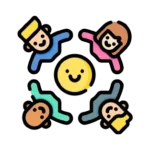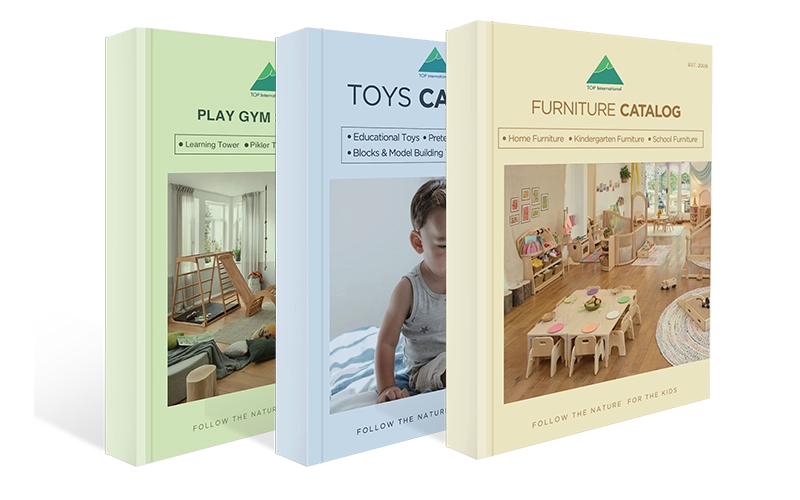Are you constantly searching for creative and engaging art activities for preschoolers? Do your current ideas feel repetitive or too messy to manage? Wondering how to introduce art that encourages creativity while also supporting early development? Do you wish there were more structured, age-appropriate ways to inspire artistic expression in young children?
Art activities for preschoolers are more than just fun—they’re essential for cognitive, emotional, and motor development. Through painting, drawing, cutting, and crafting, children build fine motor skills, express emotions, boost confidence, and learn problem-solving. These activities also promote imagination and language development, helping young learners make sense of the world around them.
This article will guide you through 50 exciting art activities for preschoolers—perfect for classrooms, daycare centers, or even home learning environments.
What Should a Preschooler Be Able to Do?
When we talk about early childhood development, one of the most common questions parents and educators ask is: “What should a preschooler be able to do?” The answer isn’t one-size-fits-all, but there are some essential developmental milestones most preschoolers (ages 3 to 5) typically reach—and art activities for preschoolers play a massive role in supporting them.
At this stage, children begin to develop their independence, creativity, communication, and motor skills. From stacking blocks to drawing stick figures, each activity contributes to a child’s cognitive and emotional development. Art, in particular, is one of the most powerful tools to nurture these foundational abilities in a way that feels natural and enjoyable.
Key Milestones Preschoolers Should Reach
By the time a child reaches preschool age, they should begin demonstrating growth in the following areas:
- ทักษะการเคลื่อนไหวที่ดี – such as holding a crayon, cutting with scissors, or gluing pieces of paper. These are often developed through repetitive, hands-on art activities for preschoolers, including coloring, painting, and crafting.
- ทักษะการเคลื่อนไหวร่างกายโดยรวม – such as jumping, skipping, and balancing, which can be enhanced through large-format or movement-based art projects like sidewalk chalk murals or dancing with ribbons.
- Language development – through storytelling, describing their artwork, or engaging in group art projects. Art gives children a visual language to express emotions and ideas even before they master verbal communication.
- Cognitive thinking – like understanding patterns, solving simple problems, or following step-by-step instructions. Many preschool art activities involve sequencing (first glue, then glitter) and decision-making (which color to use, where to draw the lines), boosting early problem-solving skills.
- Social-emotional skills – including sharing materials, working alongside peers, and expressing personal experiences or emotions through art. When children work on collaborative murals or group projects, they begin learning teamwork and empathy.

How do Art Activities for Preschoolers Help Them Grow?
Art activities for preschoolers are more than just colorful crafts or a way to pass the time. In early childhood education, art is a vital developmental tool. It supports a child’s growth on every level—physical, emotional, cognitive, and social—while also nurturing creativity and curiosity. The power of art lies in its ability to be both expressive and educational at the same time.
One of the most visible benefits of art is in the development of fine motor skills. When preschoolers paint with brushes, draw with crayons, tear paper, or cut with child-safe scissors, they are practicing control over small hand and finger movements. These actions strengthen the muscles required for writing, tying shoelaces, and other essential daily tasks. The more a child engages in art, the more naturally their fine motor coordination improves.

Beyond physical skills, art is also a powerful tool for emotional development. Children may not always have the words to express what they’re feeling—but through painting, drawing, or clay modeling, they can release their emotions and explore their inner world. Art gives them a non-verbal language to express joy, fear, excitement, or frustration. This safe outlet can also help children develop self-awareness and learn to regulate their emotions over time.
What makes art activities for preschoolers truly special is how they engage the whole child. They provide open-ended exploration while still teaching important concepts. They give freedom of expression while also encouraging structure and planning. And most importantly, they build confidence. A child who sees their artwork displayed in the classroom or praised by a caregiver begins to feel capable and valued.
By consistently offering a variety of age-appropriate art experiences, we are not just helping children stay busy—we are helping them grow into confident, expressive, and curious learners who are ready for the world ahead.
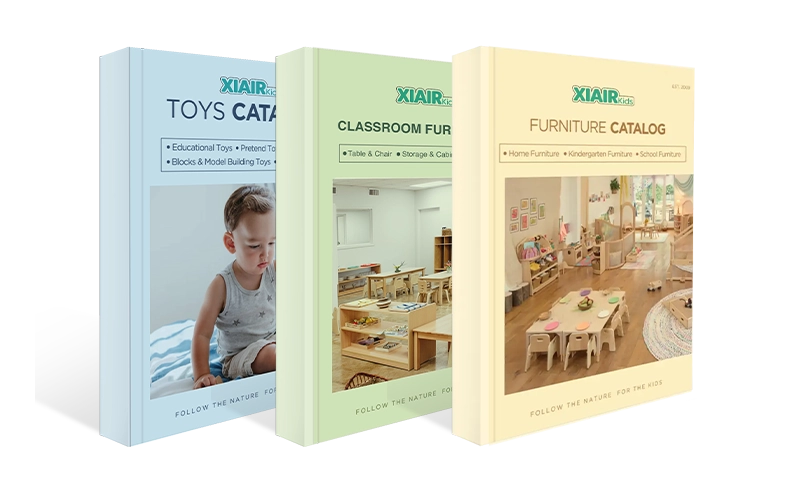
Receive a free catalog and custom layout to help you design your ideal classroom easily.
50 Ideas Art Activities For Preschoolers
The truth is, art in early childhood isn’t about the perfect final product. It’s about process, exploration, and discovery. Through painting, drawing, cutting, pasting, sculpting, and coloring, children strengthen their fine motor skills, express emotions, develop problem-solving abilities, and build self-confidence. Even a basic project like finger painting or making a paper collage becomes an opportunity for learning, growth, and joy.
That’s why I’ve put together this list of 50 creative art activities for preschoolers—a collection of hands-on, engaging ideas that support early development while keeping things fun and imaginative. From seasonal crafts to open-ended process art, these ideas are perfect for any classroom or home environment.
Make Name Art with Name Coloring Pages
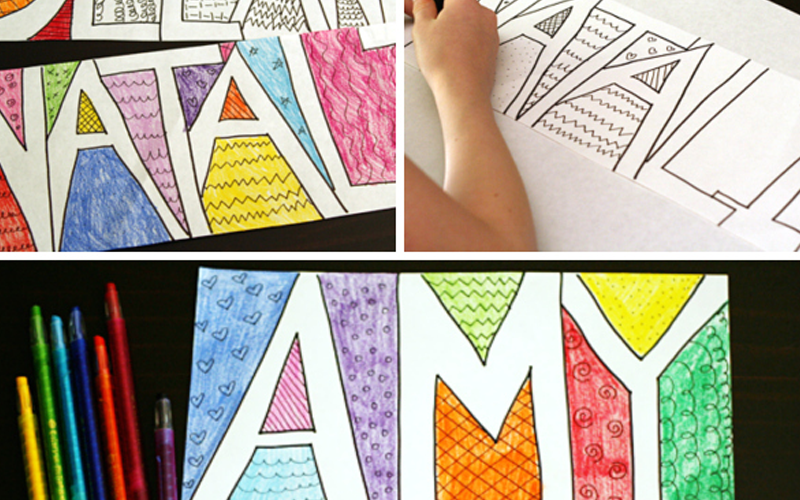
วัสดุที่ต้องใช้:
- Printed name templates
- Crayons, markers, or watercolor paints
- Stickers, glitter, and glue (optional)
- Thick cardstock or construction paper
How to Make It:
Print each child’s name in large bubble letters on sturdy paper. Offer crayons, paint, or markers for coloring. Children can personalize their names with stickers, glitter glue, or small craft items. For older preschoolers, encourage them to write or trace the letters themselves to add an extra literacy component.
Why It’s Beneficial:
This helps reinforce name recognition and spelling while promoting creative freedom. It supports fine motor development, hand-eye coordination, and a sense of identity and belonging within a group setting.
Paint with Bubbles
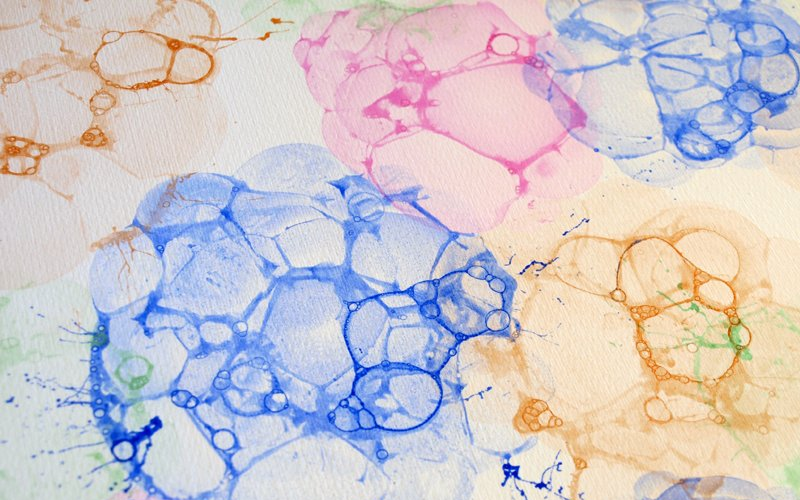
วัสดุที่ต้องใช้:
- Bubble solution
- Food coloring or washable paint
- Small cups or trays
- Straws or bubble wands
- White paper
How to Make It:
Mix paint or food coloring into the bubble solution in shallow trays. Children blow bubbles using a straw or wand, letting them land and burst on paper to create abstract splatter effects. Layer colors for more complex designs or create themed art, like “underwater” or “sky scenes.”
Why It’s Beneficial:
It supports breath control, coordination, and visual tracking. Kids begin understanding simple science concepts such as surface tension and mixing. Plus, it’s a fun, low-pressure activity that produces stunning results.
Create a Blow Painting with Straws
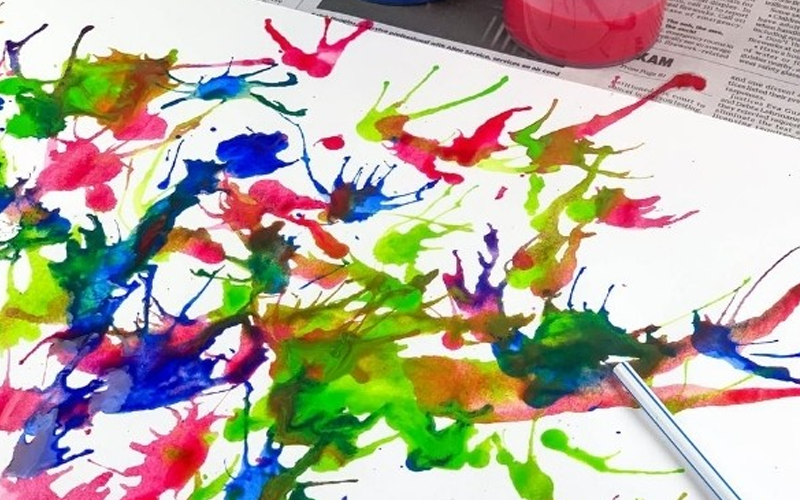
วัสดุที่ต้องใช้:
- Liquid watercolor or thinned tempera paint
- Straws
- White paper
- Eye droppers (optional)
How to Make It:
Drip or drop small amounts of paint onto paper using an eyedropper or spoon. Children then blow through a straw to move the paint around the page. They can experiment with angles, breath strength, and combining colors for exciting, one-of-a-kind artwork.
Why It’s Beneficial:
This develops oral motor skills and directional control. It also nurtures abstract thinking and planning, as children watch colors blend and make creative decisions about placement and flow.
Paint with Spray Bottles
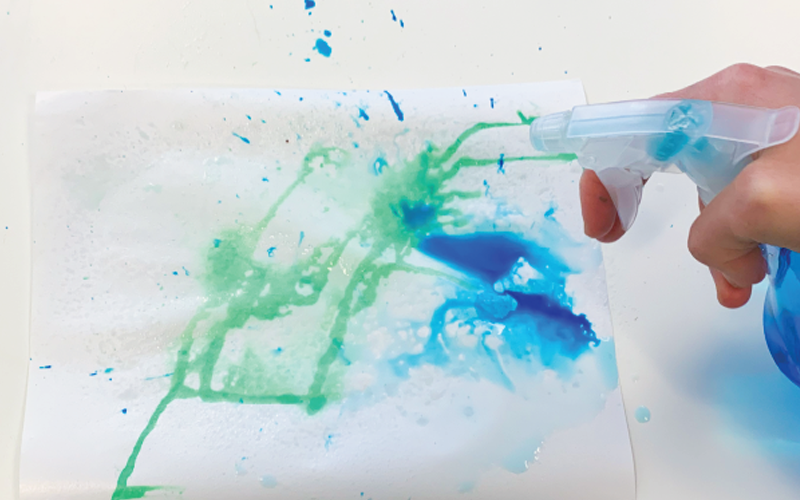
วัสดุที่ต้องใช้:
- Small spray bottles
- Watered-down paint or liquid watercolor
- Large paper or cardboard sheets
- Protective clothing or aprons
How to Make It:
Fill spray bottles with diluted paint and have children spray onto vertical or horizontal surfaces. The outdoors is best for this activity. Try taping stencils or leaves onto paper to explore negative space. You can even challenge them to “color” an entire canvas using only spray techniques.
Why It’s Beneficial:
Spray painting strengthens shoulder and arm muscles, supports bilateral coordination, and enhances gross motor control. It also introduces new ways to manipulate materials and test pressure, motion, and design ideas.
Squirt Gun Painting

วัสดุที่ต้องใช้:
- Clean squirt guns
- Washable paint mixed with water
- Large canvas or poster board
- Outdoor space
How to Make It:
Load squirt guns with watered-down paint. Set up large paper targets outdoors and let children aim and shoot paint at the surface to create vibrant, spontaneous art. You can theme the activity, such as “fireworks,” “rainbow day,” or “splash monsters.”
Why It’s Beneficial:
This is a dynamic way to build upper body strength and spatial awareness. It encourages playful creativity and introduces elements of aim, direction, and artistic freedom through action-based learning.
Paint with Feathers
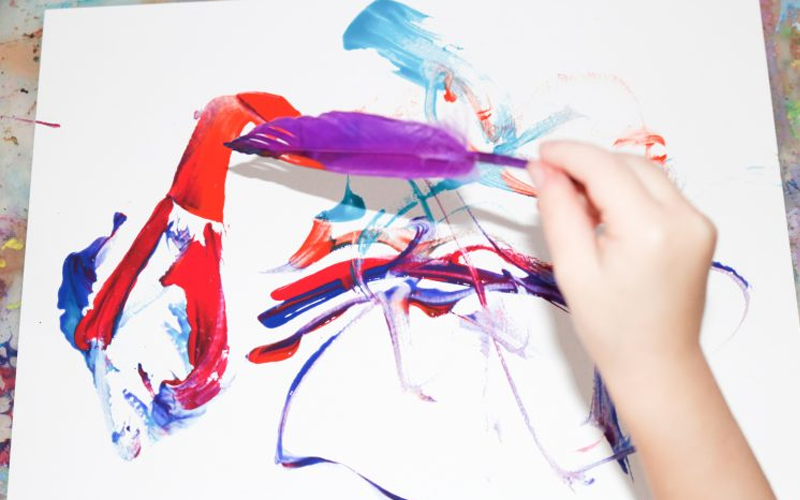
วัสดุที่ต้องใช้:
- Feathers (natural or craft)
- สีล้างได้
- กระดาษ
- Trays for paint dipping
How to Make It:
Dip the tip or sides of feathers into paint and dab or drag across the paper to create light, textured lines. Try using feathers of different shapes and sizes to compare results. You can also blow air on painted feathers to explore movement.
Why It’s Beneficial:
This activity introduces sensory textures and encourages gentle, controlled motion. It enhances focus, patience, and grip variety—all important for pre-writing development.
Pool Noodle Art
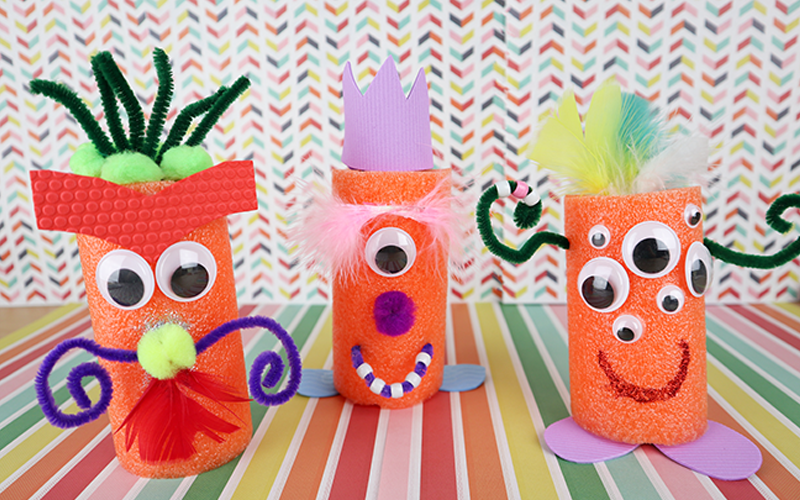
วัสดุที่ต้องใช้:
- Sliced pool noodles (2–3 inches thick)
- Tempera paint
- Shallow trays or plates
- Large paper
How to Make It:
Slice pool noodles and dip the flat ends into paint. Children can stamp shapes onto paper to create patterns, letters, or abstract designs. Pool noodles are also great for rolling, dragging, or stacking in paint for added dimension.
Why It’s Beneficial:
Perfect for little hands, this stamping method builds hand strength and introduces ideas of repetition, rhythm, and color layering. The chunky grip helps children refine their palm control and motor planning.

Receive a free catalog and custom layout to help you design your ideal classroom easily.
Summer Art Activities with Chalk
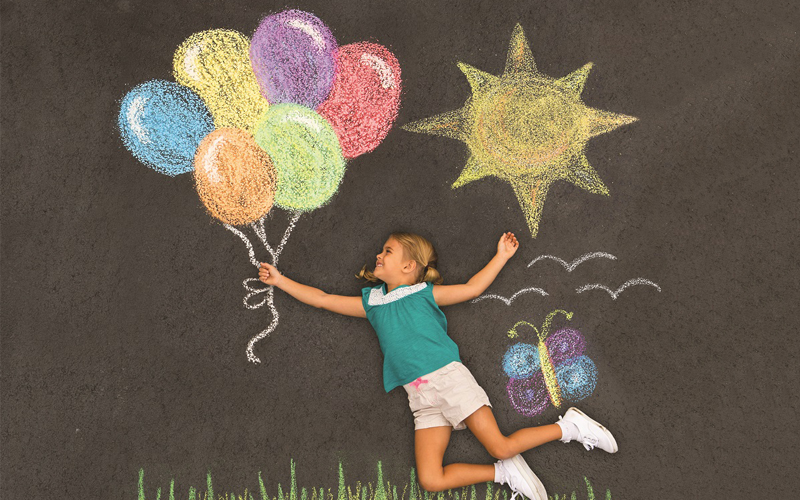
วัสดุที่ต้องใช้:
- Sidewalk chalk
- Water spray bottles or brushes
- Sidewalk space or black construction paper
How to Make It:
Children draw with chalk on sidewalks or black paper. Add water with brushes or spray bottles to blend colors or create drip effects. Try outlining body shapes or drawing summer scenes like sunshine, beaches, or ice cream.
Why It’s Beneficial:
These outdoor art activities for preschoolers boost large muscle coordination, introduce layering techniques, and support collaboration. It’s also a fantastic way to get creative while soaking up sunshine and fresh air.
Frozen Paint Art

วัสดุที่ต้องใช้:
- Ice cube trays
- Washable paint and water
- แท่งไอติม
- กระดาษ
- Freezer
How to Make It:
Mix paint with water and pour into trays. Insert popsicle sticks and freeze. Once solid, kids can use the frozen cubes like paintbrushes. As the ice melts, it leaves soft, water-colored marks.
Why It’s Beneficial:
Great for sensory exploration and scientific thinking. It engages touch, sight, and temperature perception, while encouraging kids to predict outcomes and enjoy the element of surprise.
Glue Resist Art

วัสดุที่ต้องใช้:
- กาวขาว
- Watercolor paints
- Thick paper
- แปรงทาสี
How to Make It:
Draw simple shapes or letters with glue on the paper and let them dry completely (overnight if needed). Once dry, paint over the whole page using watercolor. The dried glue resists the paint and reveals the original design.
Why It’s Beneficial:
This layered art experience teaches patience, sequencing, and design thinking. Children develop curiosity as they anticipate the final image, and they learn how materials react to one another.
Watercolor Texture Art

วัสดุที่ต้องใช้:
- Watercolor paints
- Watercolor paper
- Plastic wrap, salt, or sponges
- แปรงทาสี
- Cups of water
How to Make It:
Let children paint freely on watercolor paper using diluted paints. While the paint is still wet, sprinkle coarse salt over the surface or place crumpled plastic wrap on top. After drying, remove the materials to reveal unique textured patterns.
Why It’s Beneficial:
This art activities for preschoolers teaches cause and effect while exploring texture and pattern. It also enhances observation skills and introduces early scientific thinking about material interaction.
Airplane Printing Art
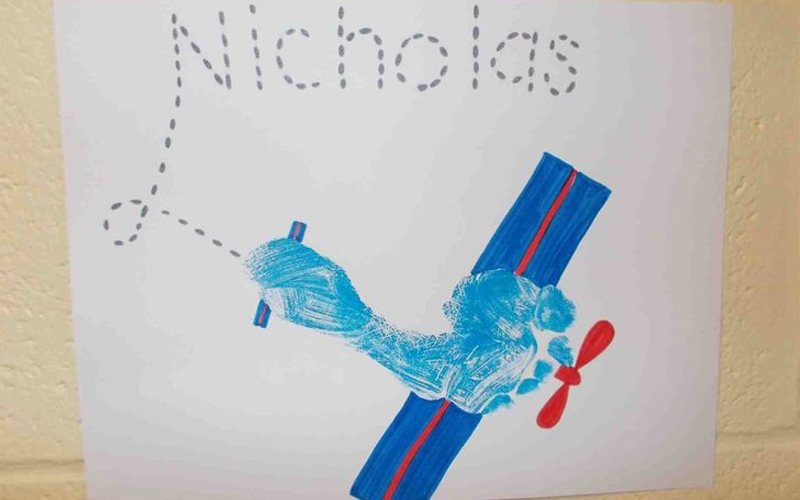
วัสดุที่ต้องใช้:
- Toy airplanes with textured wheels or wings
- สีล้างได้
- Large sheets of paper
- Shallow trays for paint
How to Make It:
Dip the wheels or wings of toy airplanes into paint. Children then “fly” the plane across the paper, creating tracks, streaks, and patterns as they go. Try combining different colors or incorporating sound effects to make the experience more immersive.
Why It’s Beneficial:
This activity strengthens gross motor coordination and grip strength. It encourages imaginative play while introducing the basics of printmaking, all through a familiar and engaging toy.
Cone Printing Art
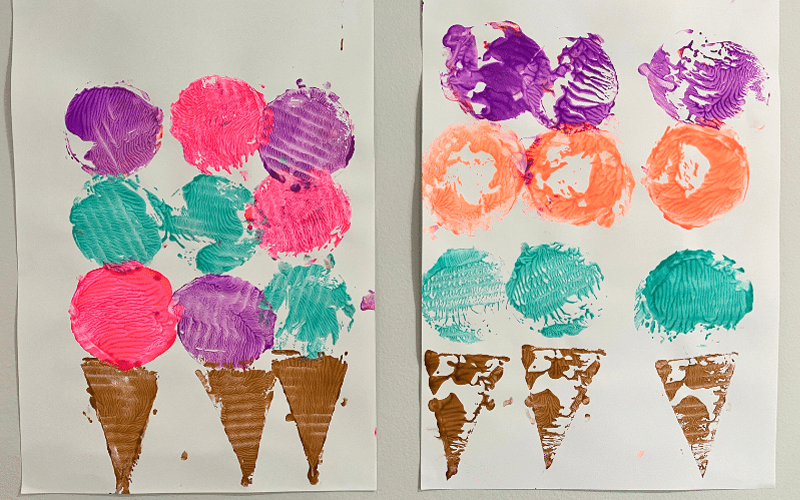
วัสดุที่ต้องใช้:
- Ice cream cones (sugar cones or foam versions)
- Tempera or acrylic paint
- กระดาษหรือกระดาษแข็งขนาดใหญ่
- Paint trays
How to Make It:
Dip the bottom edge or textured surface of the cone into paint and stamp it onto the paper. Children can roll or press it in different directions to see what shapes emerge.
Why It’s Beneficial:
Using unconventional tools encourages creative thinking and experimentation. It supports sensory exploration and motor planning while introducing early geometry through shapes and repetition.
Citrus Printing Art
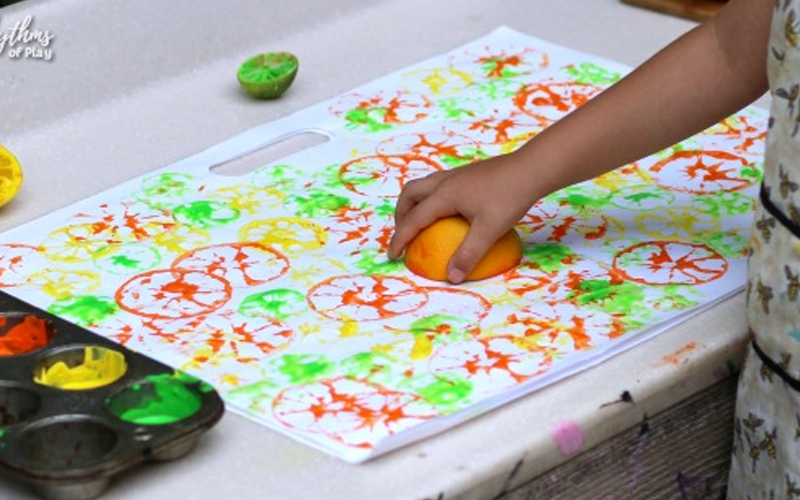
วัสดุที่ต้องใช้:
- Sliced oranges, lemons, or limes
- สีล้างได้
- จานกระดาษ
- Thick drawing paper
How to Make It:
Dip the flat side of the citrus slices into paint and stamp them onto the paper. Children can try layering prints, exploring symmetry, or even mixing colors directly on the fruit for variety.
Why It’s Beneficial:
This activity blends art with sensory science. Children explore textures, patterns, and even smell, enhancing sensory processing and creativity through multi-sensory input.
Pool Noodle 3D Art
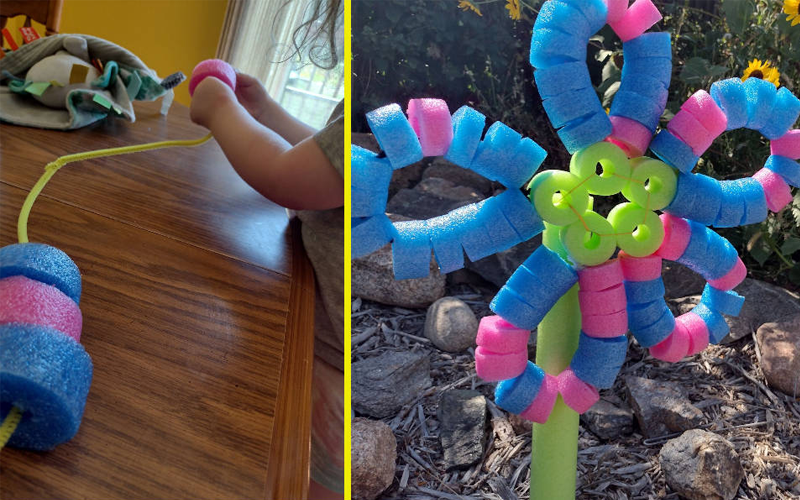
วัสดุที่ต้องใช้:
- Pool noodles (cut into rings or shapes)
- Hot glue (used by adults)
- สีล้างได้
- Cardboard or canvas
- Brushes
How to Make It:
Pre-cut and pre-glue different pool noodle shapes onto canvas or thick cardboard to create a raised, 3D surface. Children can then paint over and around the forms, exploring dimension and layering.
Why It’s Beneficial:
This project combines tactile and visual elements, supporting spatial awareness, texture recognition, and creative decision-making. It’s also a fantastic way to transition into sculpture for preschoolers.

Receive a free catalog and custom layout to help you design your ideal classroom easily.
Cotton Candy Puffy Art

วัสดุที่ต้องใช้:
- ครีมโกนหนวด
- กาวขาว
- Food coloring or paint
- Mixing bowls
- Cotton balls (optional)
How to Make It:
Mix shaving cream and glue in equal parts, adding a few drops of paint or food coloring. Children use brushes or fingers to apply the mixture to paper in thick swirls. For added effect, cotton balls can be placed on top for texture.
Why It’s Beneficial:
This sensory-rich activity develops fine motor control and introduces the concept of volume and texture. The puffy effect creates visual excitement and engages multiple senses at once.
Neon Painting

วัสดุที่ต้องใช้:
- Neon or fluorescent paint
- กระดาษก่อสร้างสีดำ
- Brushes, cotton swabs, or sponges
- Optional: UV light or black light
How to Make It:
Children paint on black paper using neon paints to create bright, high-contrast images. Add UV light to see the artwork glow, turning a simple painting activity into an exciting visual discovery.
Why It’s Beneficial:
Neon art supports color recognition, contrast awareness, and visual tracking. It’s also highly motivating for children who respond to bold, bright visual stimuli.
Splatter Art
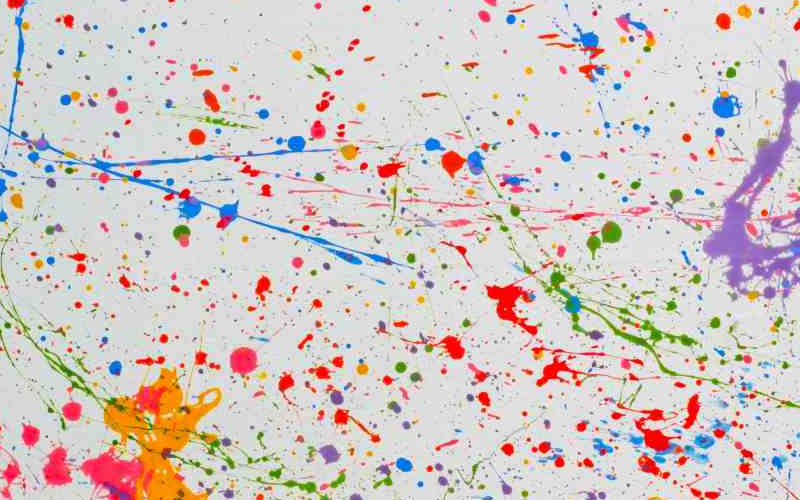
วัสดุที่ต้องใช้:
- Tempera or watercolor paint
- Old toothbrushes or paintbrushes
- Cardstock or poster board
- Aprons and protective table coverings
How to Make It:
Dip brushes in paint and use fingers or sticks to flick the bristles, splattering paint across the paper. Children can experiment with different directions, colors, and flicking tools for varied effects.
Why It’s Beneficial:
This is an excellent energy release activity. It enhances muscle coordination, builds control, and teaches children how different motions impact outcomes—an early lesson in physics and pattern creation.
Summer Spin Art
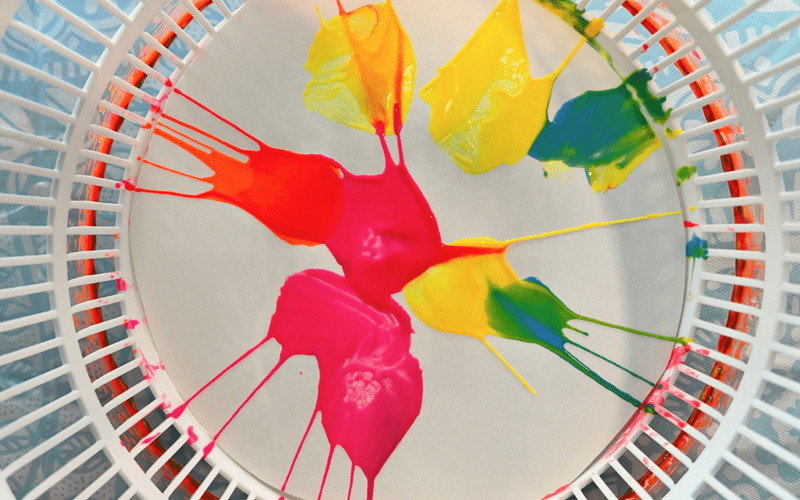
วัสดุที่ต้องใช้:
- Salad spinner
- Circular paper (cut to size)
- Liquid paint
- Spoons or droppers
How to Make It:
Place a round paper piece inside the salad spinner. Drop in a few colors of paint, then let children spin it by turning the handle. Open the lid to reveal a swirling, vibrant design.
Why It’s Beneficial:
Spin art supports arm strength and bilateral coordination. It also introduces centrifugal force in a hands-on, age-appropriate way. Children delight in the surprise outcome, fostering curiosity and excitement.
Fish Painting
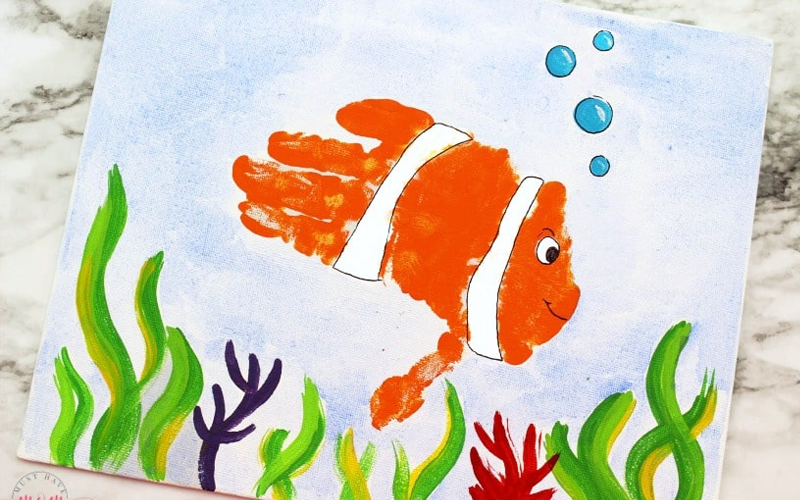
วัสดุที่ต้องใช้:
- Printable fish templates or blank fish shapes
- Watercolor or tempera paint
- Markers or oil pastels
- Brushes and accessories like sequins or tissue paper
How to Make It:
Children begin with a fish shape and decorate it using paint, drawing scales, adding glitter, or gluing on paper fins. Try turning this into a group mural by combining fish on an extensive background with a sea scene.
Why It’s Beneficial:
This themed activity allows for storytelling and creative thinking. It helps children focus on detail, introduces biological forms (like fish anatomy), and supports sequencing skills through step-by-step crafting.
Animal Painting

วัสดุที่ต้องใช้:
- Printable animal outlines or stencils
- Tempera or watercolor paints
- Brushes, cotton swabs, or sponges
- Large paper
How to Make It:
Provide children with pre-drawn or printed animal outlines. Let them paint freely using tools like brushes or sponges to decorate each animal. Encourage them to use real-life colors or explore wild, imaginary designs.
Why It’s Beneficial:
This activity supports shape recognition and categorization. It helps children understand the animal world while allowing for expression and color experimentation—core components of art activities for preschoolers.
Safari Sunset Painting

วัสดุที่ต้องใช้:
- Watercolor or tempera paint
- กระดาษก่อสร้างสีดำ
- Brushes and sponges
- Pre-cut animal silhouettes (optional)
How to Make It:
Children paint sunset gradients on large paper using warm tones (orange, red, yellow). Once dry, they add black silhouettes of safari animals and trees to create a striking scene.
Why It’s Beneficial:
This project introduces layering and background-foreground concepts. It builds visual storytelling skills and color theory understanding, key aspects of early artistic development.
Zoo Animal Collages
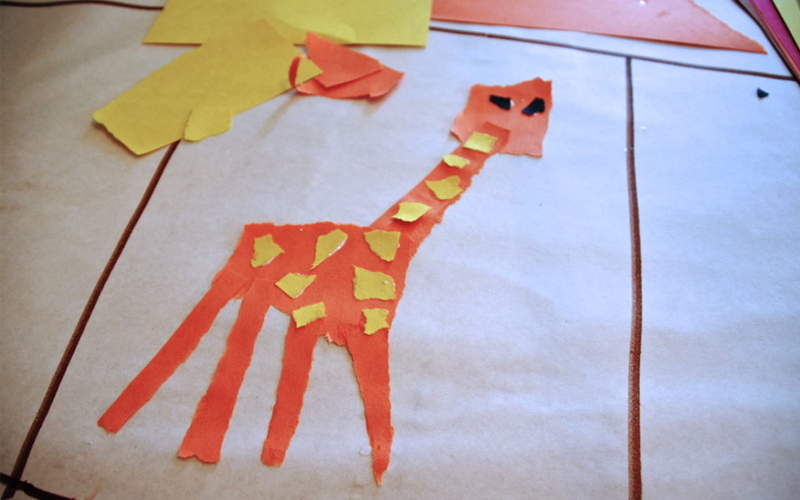
วัสดุที่ต้องใช้:
- Animal magazines or printed images
- กรรไกรตัดความปลอดภัย
- กาวแท่ง
- Poster board
How to Make It:
Let preschoolers cut or tear out animal images and glue them onto a large board. They can sort them into zoo zones (aquatic, jungle, etc.) or make silly combinations of animal parts.
Why It’s Beneficial:
Collaging supports fine motor skills, classification, and creativity. It’s one of the most effective art activities for preschoolers to combine art with early science and vocabulary building.
Snake Spiral Art

วัสดุที่ต้องใช้:
- Paper plates or cardstock circles
- Markers, paint, or crayons
- กรรไกรตัดความปลอดภัย
- Googly eyes or stickers
How to Make It:
Draw a spiral starting from the center of a paper plate. Let children decorate it with patterns, scales, or colors, then cut along the spiral. Add eyes to make a hanging snake craft.
Why It’s Beneficial:
Children practice patterning, scissor control, and circular motion, which builds hand-eye coordination and bilateral integration.
Paper Bag Jellyfish

วัสดุที่ต้องใช้:
- Brown or white paper bags
- สีและพู่กัน
- Yarn, streamers, or ribbon
- เครื่องเจาะรู
How to Make It:
Children paint the paper bags, then add streamers or ribbons to the open end using a hole punch and string. Once complete, the jellyfish can hang or float in pretend play.
Why It’s Beneficial:
This is an excellent tactile and sensory-based activity that strengthens creative expression and introduces underwater themes to preschoolers in a hands-on format.

Receive a free catalog and custom layout to help you design your ideal classroom easily.
Ice Painting
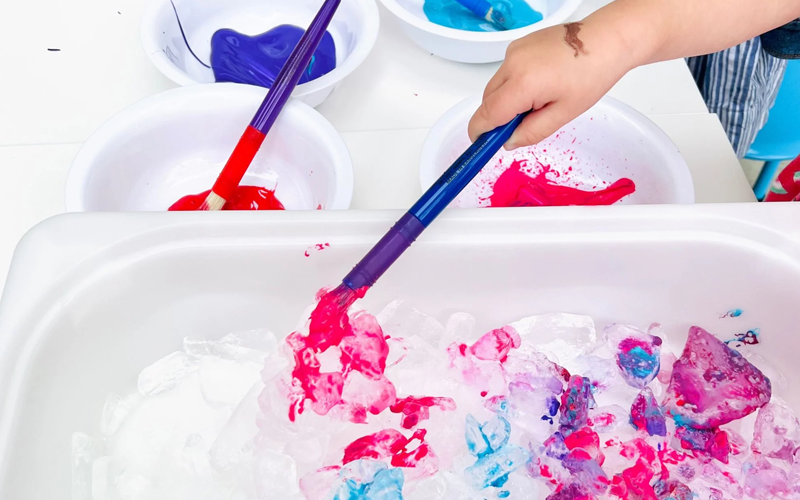
วัสดุที่ต้องใช้:
- Ice cubes or frozen paint blocks
- Liquid watercolor or food coloring
- แท่งไอติม
- กระดาษ
How to Make It:
Freeze water with added color in trays. Add sticks before freezing. Children use the melting cubes like brushes, painting as the ice melts onto paper.
Why It’s Beneficial:
This is a classic sensory-based art activities for preschoolers. It introduces temperature, texture, and cause-and-effect while strengthening grip and control.
Paper Bag Kite
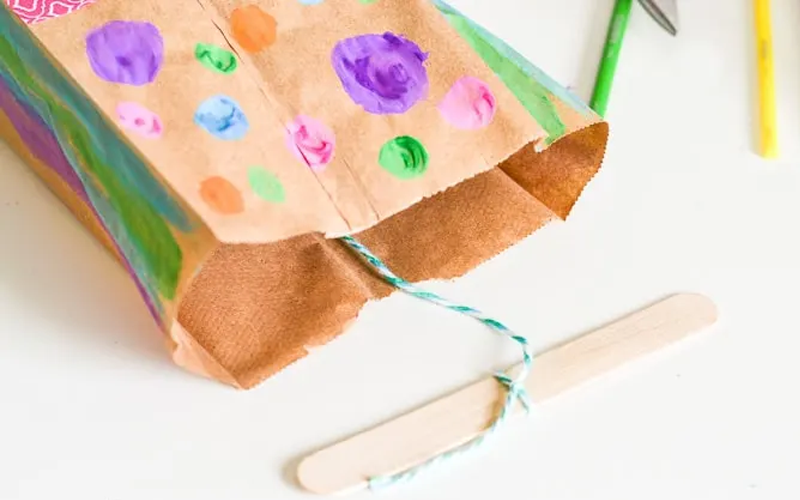
วัสดุที่ต้องใช้:
- Paper lunch bags
- Markers, crayons, or paint
- Yarn or ribbon
- Tape and hole punch
How to Make It:
Decorate paper bags with colorful designs. Punch holes at the bottom and tie on ribbon or yarn tails. Attach a looped string at the top so the kite can be “flown” during movement play.
Why It’s Beneficial:
Combines art with physical activity. It promotes gross motor movement, creative design, and exploration of wind and motion concepts.
Tissue Paper Apple
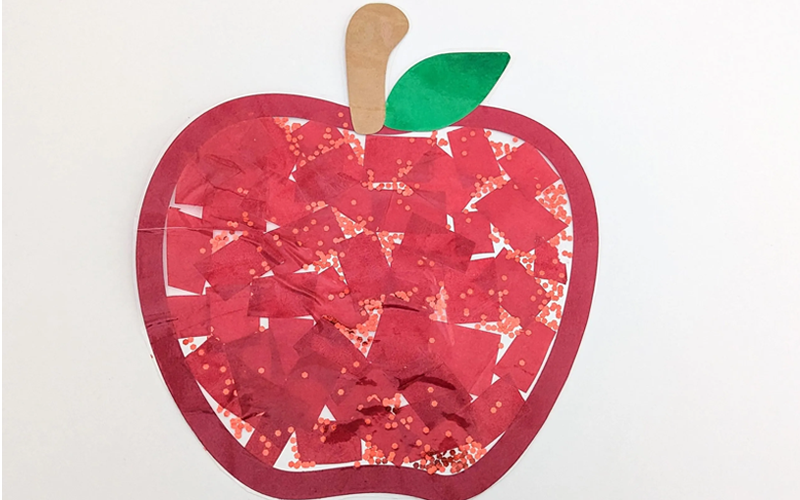
วัสดุที่ต้องใช้:
- Red, green, and brown tissue paper
- กาวแท่ง
- Apple outline on cardstock
- Scissors (optional)
How to Make It:
Tear or cut tissue paper into small pieces. Children glue them inside the apple shape to create a vibrant collage. For realism, add a green stem and brown leaf.
Why It’s Beneficial:
This activity builds finger strength and visual perception. It’s ideal for fall-themed units or nutrition discussions while offering classic art activities for preschoolers, with sensory value.
Fork Print Tulips
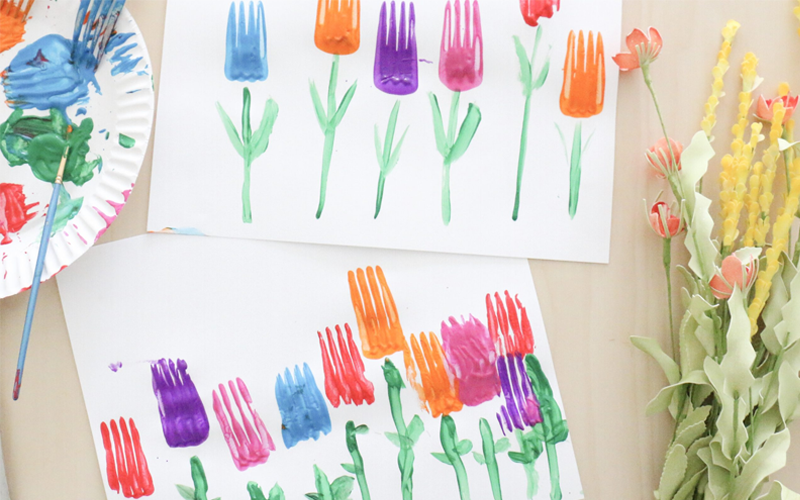
วัสดุที่ต้องใช้:
- Plastic forks
- Paint in multiple colors
- Cardstock
- Brushes or optional green paint for stems
How to Make It:
Dip the back side of a fork into paint and press it onto paper to make tulip flower shapes. Repeat with different colors. Add stems using brushes or fingers.
Why It’s Beneficial:
This printmaking technique strengthens grip, pressure control, and pattern recognition. It introduces a new way to paint and explore nature themes creatively.
Paper Bag Monster
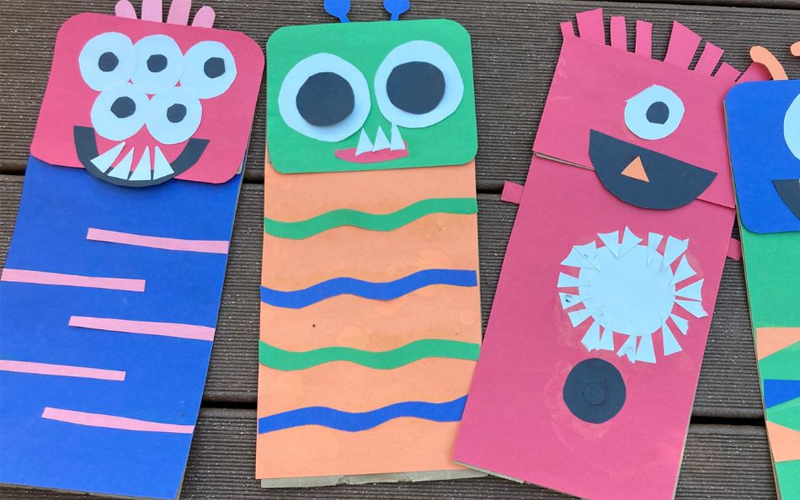
วัสดุที่ต้องใช้:
- Paper lunch bags
- Googly eyes, pom-poms, or felt shapes
- Glue, scissors, crayons, or markers
How to Make It:
Let children turn their paper bags into silly monsters with eyes, teeth, and colorful designs. Use the bags as puppets during storytelling or imaginative play.
Why It’s Beneficial:
Promotes imagination, story creation, and character building. This is one of the most playful art activities for preschoolers, combining crafting with early literacy through puppet-based storytelling.
Paper Plate Lion
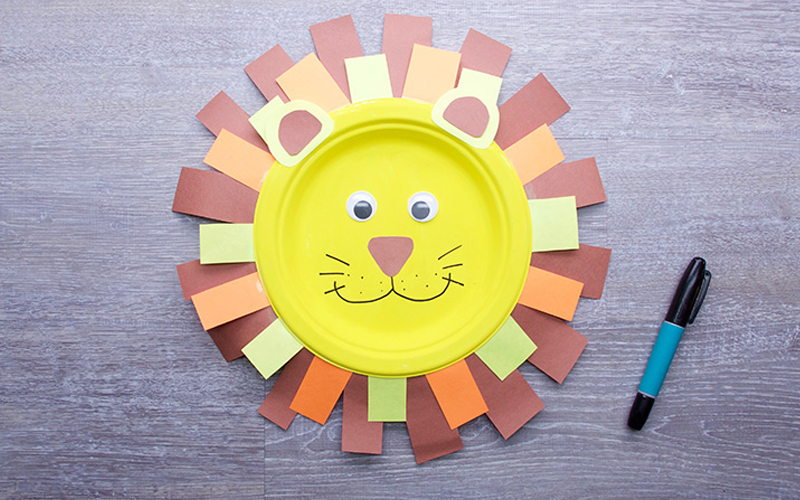
วัสดุที่ต้องใช้:
- จานกระดาษ
- Yellow and orange paint or construction paper
- ตาโปนๆ
- Brown or black marker
- กาวและกรรไกร
How to Make It:
Paint the center of the plate yellow for the lion’s face. Cut strips of orange paper and glue them around the edge as the mane, or let children paint it directly. Add eyes, nose, and draw the mouth with a marker.
Why It’s Beneficial:
This activity strengthens cutting and gluing skills, supports color recognition, and introduces basic animal features. It’s a great addition to animal-themed art activities for preschoolers.
Popsicle Stick Rainbow
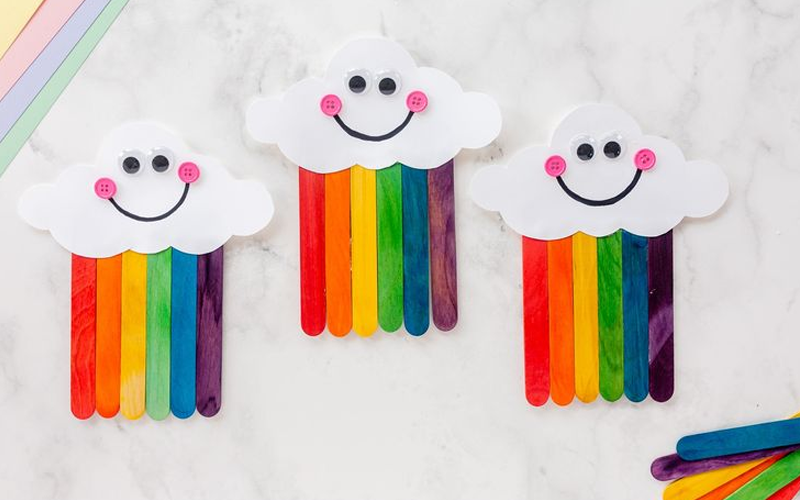
วัสดุที่ต้องใช้:
- แท่งไอติม
- Paint or colored markers
- กาว
- Cotton balls or white paper
- Cardstock
How to Make It:
Paint popsicle sticks in rainbow colors. Once dry, glue them in a curved rainbow shape on cardstock. Add clouds made of cotton balls at each end for a 3D effect.
Why It’s Beneficial:
Children develop color order recognition, hand coordination, and spatial awareness. Rainbows also serve as a fun way to introduce sequencing and color mixing.
Paper Plate Octopus
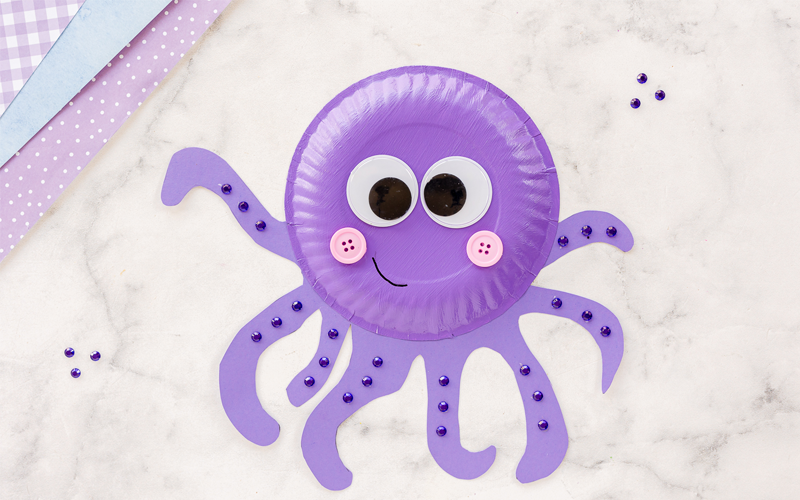
วัสดุที่ต้องใช้:
- จานกระดาษ
- Paint or markers
- Construction paper strips
- กาวและกรรไกร
- ตาโปนๆ
How to Make It:
Cut a paper plate in half and let children decorate it as an octopus head. Add eight paper strip legs and glue them to the back. Finish with googly eyes and smiley faces.
Why It’s Beneficial:
This project reinforces counting, improves fine motor control, and encourages discussion about marine life. It fits nicely into underwater-themed art activities for preschoolers.
Macaroni Necklace
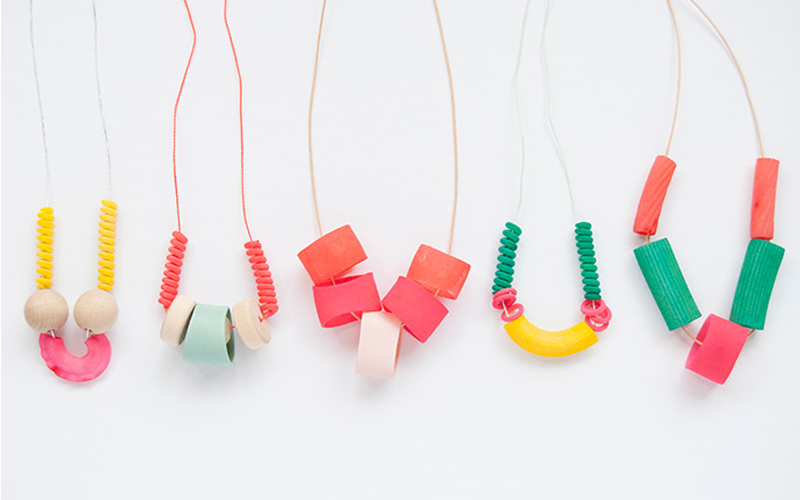
วัสดุที่ต้องใช้:
- Dry pasta (macaroni or penne)
- เชือกหรือเส้นด้าย
- Paint or food coloring
- Bowls and brushes
How to Make It:
Color the pasta ahead of time using food dye or paint. Once dry, let children string the pasta to make colorful necklaces. They can create repeating patterns or random designs.
Why It’s Beneficial:
This activity improves hand-eye coordination and pattern recognition. It also allows for creative self-expression through wearable art.
Paper Scrap Tree
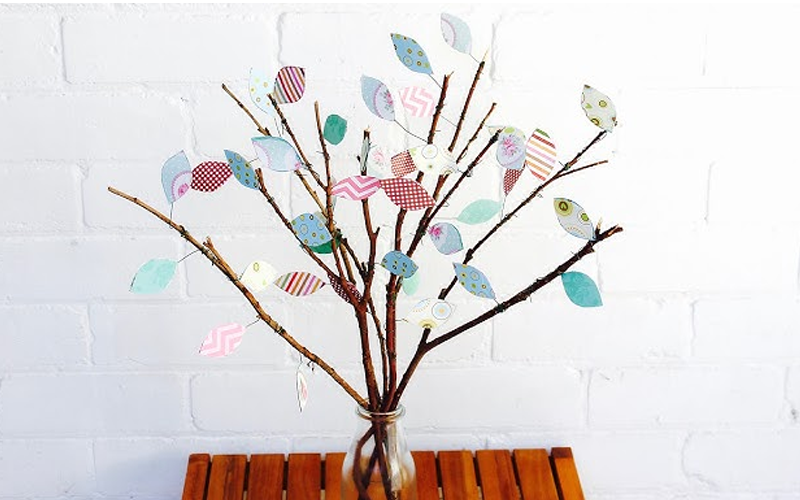
วัสดุที่ต้องใช้:
- Brown and green construction paper
- Assorted paper scraps (tissue, old drawings, etc.)
- กาวและกรรไกร
- Cardstock background
How to Make It:
Cut a tree trunk and branches from brown paper. Children glue it to a background, then tear or cut scraps to create leaves. Use seasonal colors for fall, spring, or winter effects.
Why It’s Beneficial:
It supports fine motor development, visual creativity, and seasonal awareness. It also promotes recycling and resourcefulness, an eco-friendly approach to art activities for preschoolers.
Salt Painting

วัสดุที่ต้องใช้:
- กาวขาว
- Salt
- Watercolor or liquid paint
- Watercolor paper
How to Make It:
Draw simple shapes with glue and sprinkle salt over it while wet. Let dry slightly, then use a brush to dab watercolor onto the salt and watch it spread.
Why It’s Beneficial:
This sensory-rich activity teaches absorption, reaction, and color spreading. It’s visually stunning and fosters patience, precision, and curiosity.
Colorful Chicks
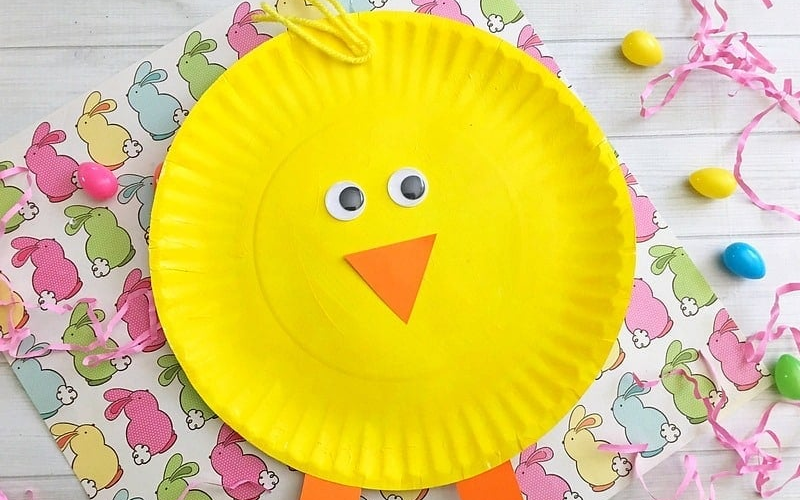
วัสดุที่ต้องใช้:
- Yellow construction paper or paper plates
- Orange paper for beaks and feet
- ตาโปนๆ
- Feathers or tissue paper
- กาวและกรรไกร
How to Make It:
Cut chick shapes from paper or plates. Using glue, let children add feathers, beaks, and feet. They can make fluffy or funny variations for spring or Easter themes.
Why It’s Beneficial:
Encourages imaginative interpretation of animals and builds texture awareness. This is a delightful way to introduce basic shapes and symmetry.
Cardboard Sculptures
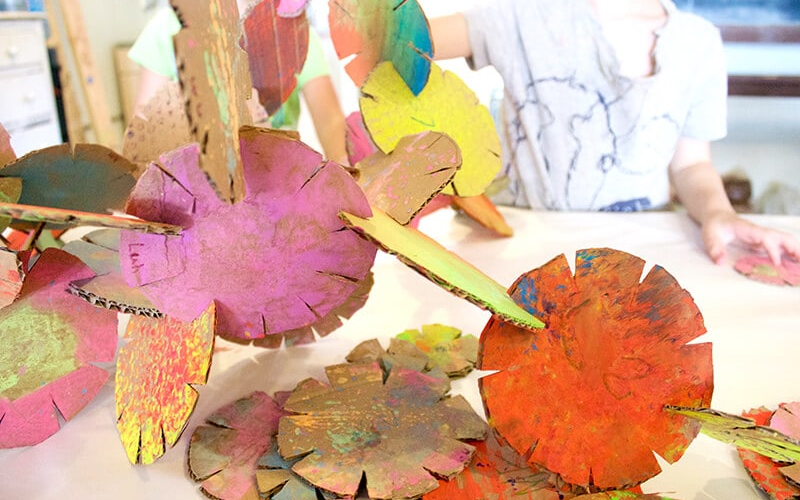
วัสดุที่ต้องใช้:
- Cardboard pieces
- Scissors and a hole punch
- สี
- Glue (or slits for slotting pieces together)
How to Make It:
Cut cardboard into various shapes and sizes. Let kids paint or decorate them. Punch holes or cut slits so children can fit pieces together to build freeform sculptures.
Why It’s Beneficial:
One of the best open-ended art activities for preschoolers, this project develops spatial reasoning, balance, and creative construction.
Paper Plate Snake
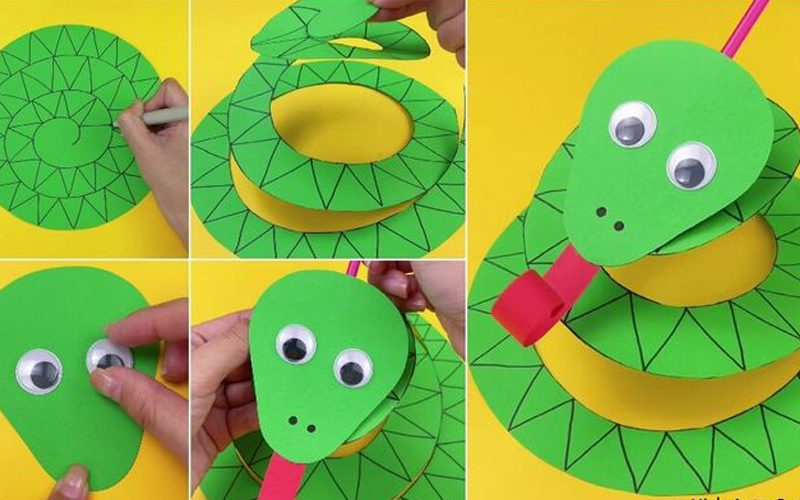
วัสดุที่ต้องใช้:
- จานกระดาษ
- Paint and markers
- กรรไกร
- ตาโปนๆ
- String (optional)
How to Make It:
Paint a paper plate, then cut it into a spiral starting from the outside edge. Add eyes and a tongue to the head end. Optionally, attach a string to hang it as a mobile.
Why It’s Beneficial:
Strengthens scissors skills and fine motor control. The spiral cutting and painting support understanding of motion and repetition.
Paper Roll Koala
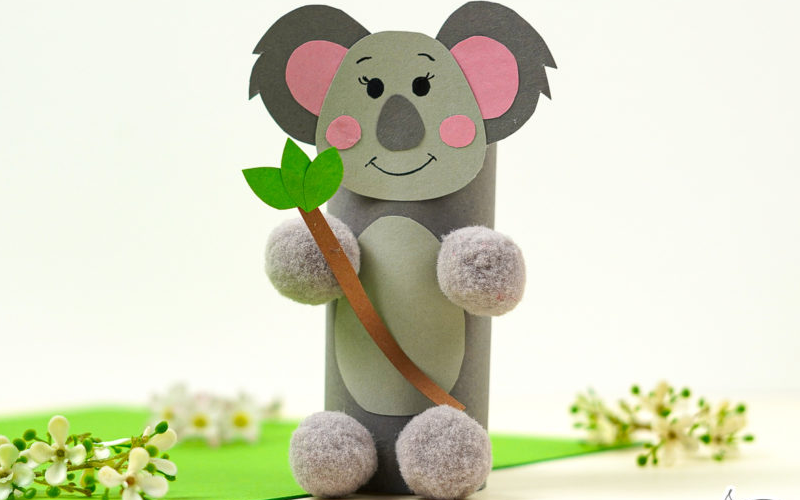
วัสดุที่ต้องใช้:
- Toilet paper rolls
- Gray paint or paper
- White and black paper for face parts
- กาวและกรรไกร
- ตาโปนๆ
How to Make It:
Wrap or paint the paper roll gray. Add paper ears, eyes, nose, and draw or glue a slight belly. Let children place their koalas on branches made from paper towel tubes.
Why It’s Beneficial:
This activity supports shape recognition, grip, and theme-based storytelling. It’s an excellent project for animal units and environmental awareness.
Leaf Pattern Drawing
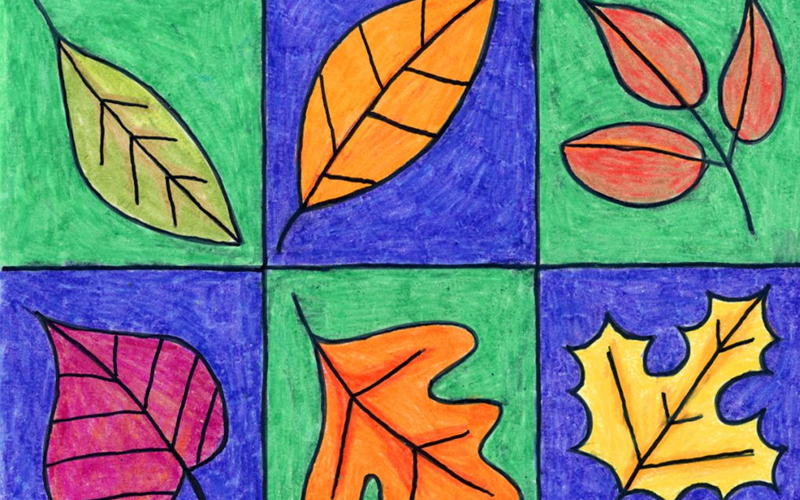
วัสดุที่ต้องใช้:
- Fresh or dried leaves
- Crayons, colored pencils, or markers
- White paper
- Optional: Magnifying glass
How to Make It:
Place leaves underneath white paper and have preschoolers rub over the surface using crayons or colored pencils to reveal the natural leaf patterns. Alternatively, children can trace leaf outlines and fill them with patterns or colors of their choice.
Why It’s Beneficial:
This is one of the best nature-based art activities for preschoolers. It encourages careful observation, introduces texture recognition, and helps develop hand strength and fine motor control through detailed rubbing and tracing.
Woven Rainbow Fish
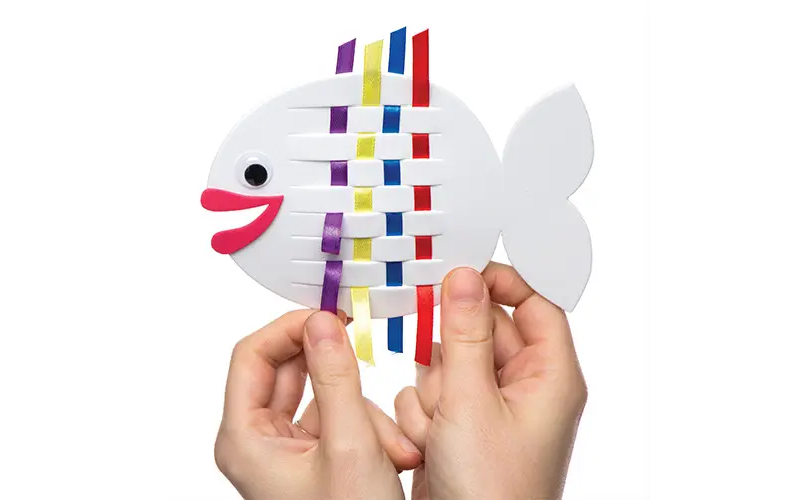
วัสดุที่ต้องใช้:
- กระดาษก่อสร้าง
- กรรไกร
- กาว
- Fish template
- Colored paper strips
How to Make It:
Start with a large fish shape with slits cut in the body. Children weave colored paper strips through the slits to form rainbow patterns. Decorate with eyes and fins.
Why It’s Beneficial:
This is an ideal choice for art activities for preschoolers that combine storytelling (e.g., The Rainbow Fish) with hand-eye coordination and sequencing. Weaving enhances bilateral skills and early pattern recognition.
Thumbprint Bugs Art
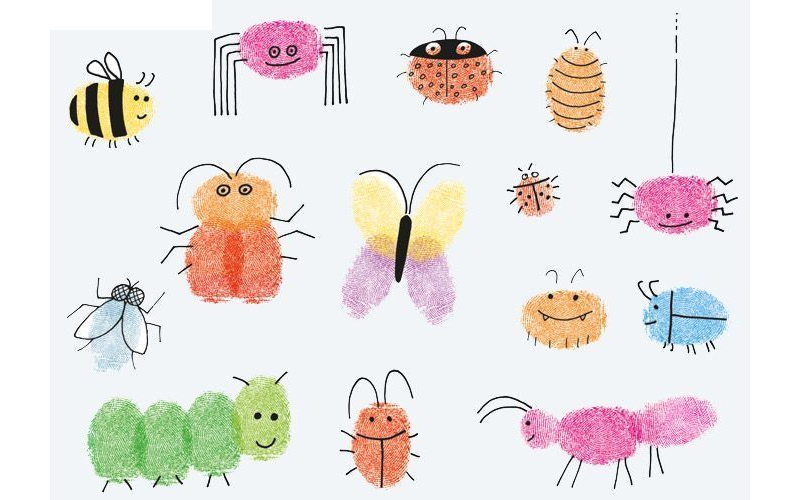
วัสดุที่ต้องใช้:
- Washable paint or ink pads
- White paper
- Markers
- Wet wipes
How to Make It:
Preschoolers dip their thumbs in paint or ink and press them on paper. After the paint dries, they use markers to turn each thumbprint into a bug—adding legs, wings, and antennae.
Why It’s Beneficial:
This is a fun, sensory-rich art activities for preschoolers that encourages imaginative thinking, early biology exploration, and fine motor skills through fingerprint stamping and line drawing.
Paper Plate Umbrella
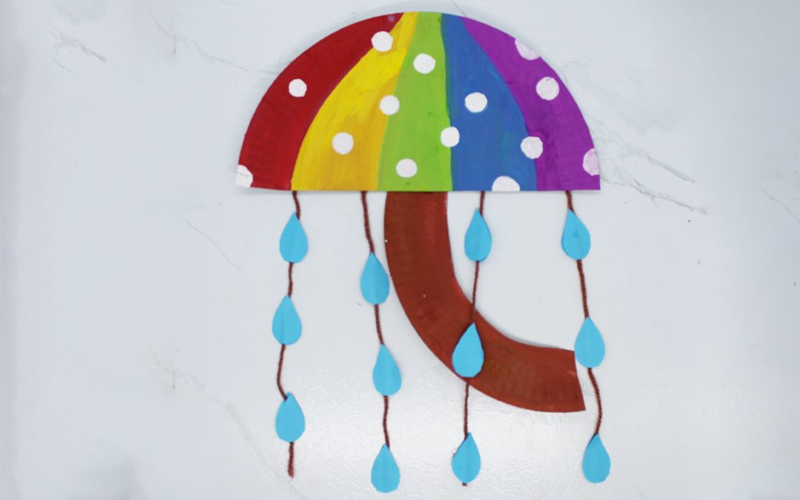
วัสดุที่ต้องใช้:
- Paper plates (cut in half)
- Paint or crayons
- เชือกหรือเส้นด้าย
- Blue construction paper
- Paper raindrops
How to Make It:
Let children decorate half a plate as an umbrella top. Punch holes along the edge and tie raindrop shapes on strings. Glue everything onto a blue background to complete a rainy-day art scene.
Why It’s Beneficial:
Weather-themed art activities for preschoolers like this one enhance seasonal awareness, color exploration, and coordination skills. Punching and tying improve hand strength and sequencing.
Popsicle Stick Pencil
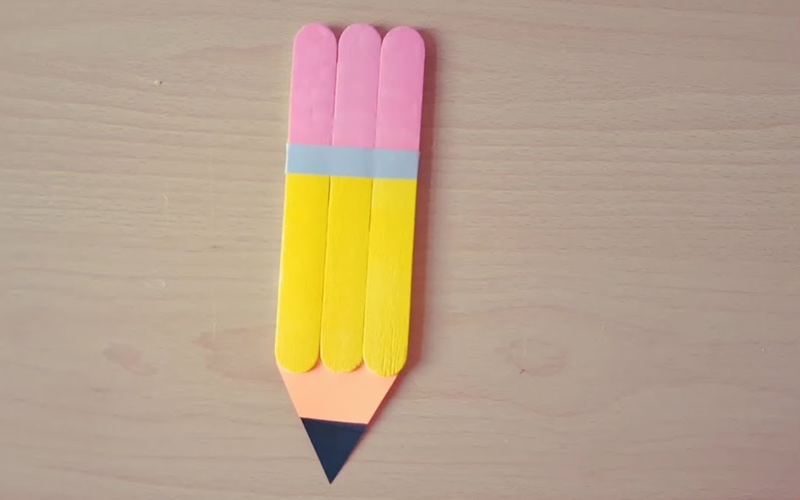
วัสดุที่ต้องใช้:
- แท่งไอติม
- Yellow, pink, and gray paint
- ปากกาเมจิกสีดำ
- Cardstock
How to Make It:
Children paint popsicle sticks to look like pencils, adding erasers, wood tips, and black points. Glue the finished pencils to cardstock for a school-themed decoration.
Why It’s Beneficial:
Among practical art activities for preschoolers, this one supports shape recognition, steady brushwork, and back-to-school conversations. It also offers a great introduction to functional design.
Craft Stick Airplane

วัสดุที่ต้องใช้:
- แท่งไอติม
- Clothespins
- สี
- กาว
How to Make It:
Children paint popsicle sticks and glue them onto clothespins to create airplane wings and tails. Encourage them to personalize their aircraft with colors or symbols.
Why It’s Beneficial:
STEM-inspired art activities for preschoolers like this support early engineering thinking, spatial skills, and confidence in assembling multi-part objects.
Pom-Pom Caterpillars
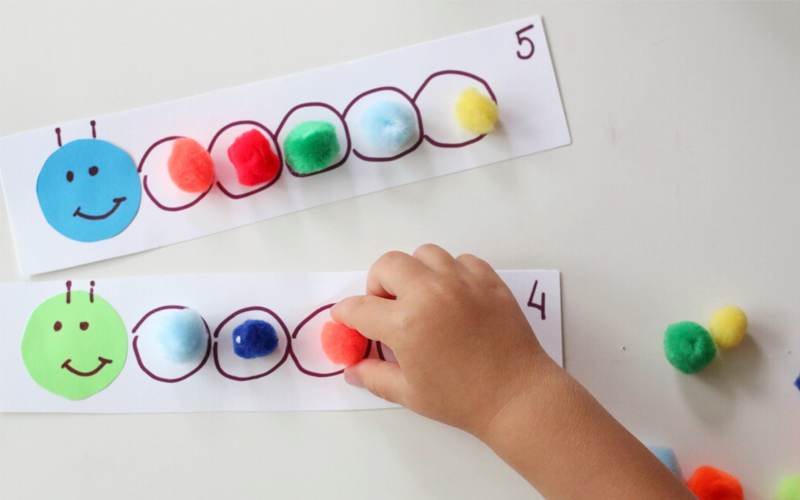
วัสดุที่ต้องใช้:
- Pom-poms
- Cardstock
- กาว
- ไม้ทำความสะอาดท่อ
- ตาโปนๆ
How to Make It:
Preschoolers glue pom-poms onto cardstock in a row to form a caterpillar. They can then add antennae with pipe cleaners and decorate with googly eyes and patterns.
Why It’s Beneficial:
A tactile and fun art activities for preschoolers, this project builds sequencing, encourages imagination, and reinforces basic science ideas like insect life cycles.
Chalk Christmas Lights

วัสดุที่ต้องใช้:
- Black paper
- Colored chalk
- White crayon
- Cotton swabs
How to Make It:
Draw a curved line to act as the wire. Have children draw or color in light bulbs using chalk and smudge the edges to create a glowing effect. Outline with white crayon.
Why It’s Beneficial:
This is a visually exciting holiday-themed art activities for preschoolers that strengthens grip, color awareness, and introduces light blending techniques.
Gratitude Journal
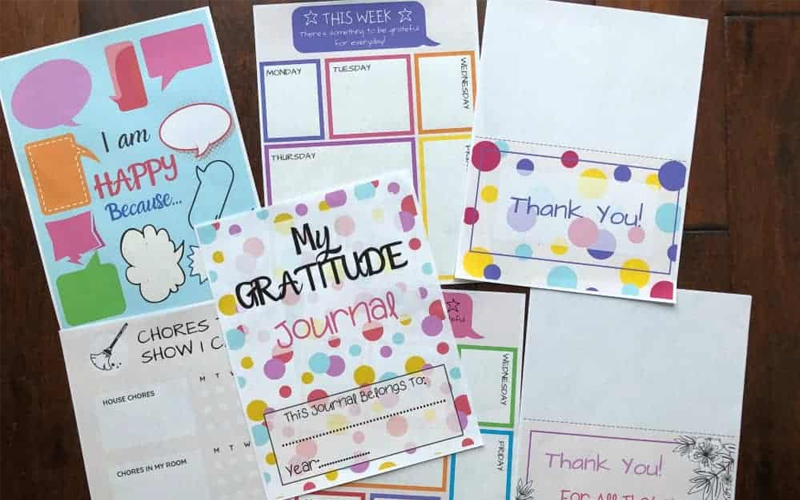
วัสดุที่ต้องใช้:
- Blank notebook or stapled paper
- ดินสอสีหรือปากกาเมจิก
- Stickers
- Daily drawing prompts
How to Make It:
Create mini journals where children decorate the cover and draw something they’re grateful for each day. Prompts can be visual or guided by conversation.
Why It’s Beneficial:
Unlike traditional crafts, this reflective art activities for preschoolers supports emotional development, vocabulary expansion, and personal expression through routine creative journaling.
Textured Hot-Air Balloon
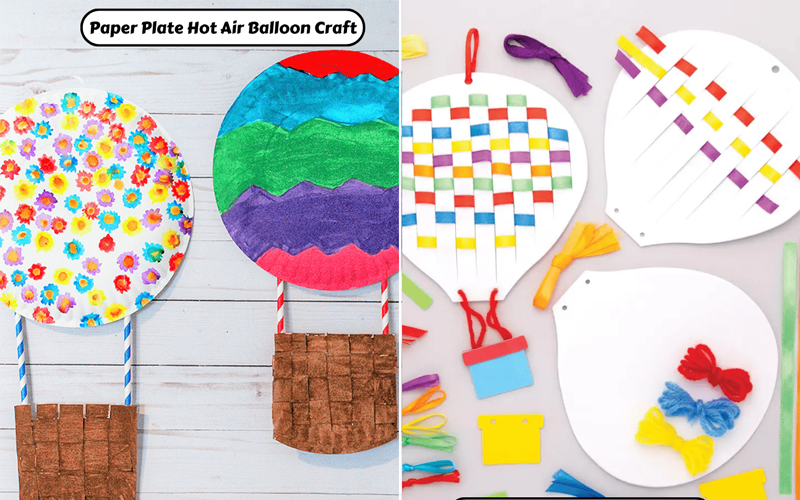
วัสดุที่ต้องใช้:
- Balloon shape templates
- Tissue paper, foil, yarn
- กาว
- กรรไกร
- Paper basket shapes
How to Make It:
Let children collage textured materials onto balloon cutouts. Glue on string and paper baskets to create a dimensional hot-air balloon that can be hung or displayed.
Why It’s Beneficial:
This is a multi-sensory art activities for preschoolers that enhances material awareness, visual layering, and storytelling. It also introduces early engineering and transportation concepts in a fun way.

Receive a free catalog and custom layout to help you design your ideal classroom easily.
Designing Creative Art Corners: Daycare Furniture That Supports Preschool Art
In every successful early learning environment, one area bursts with color, energy, and imagination—the art corner. Whether you’re setting up a daycare, preschool, or kindergarten space, thoughtfully selected daycare furniture can make all the difference in creating a space that inspires creativity, supports independence, and encourages participation in daily art activities for preschoolers.
Preschoolers need more than just paper and paint—they need a safe, accessible, and organized space to express themselves. Here’s how to design a functional, beautiful, and developmentally appropriate art area that works seamlessly with your daycare furniture setup.
Choosing the Right Tables and Seating
Furniture is the foundation of every preschool art corner. When selecting tables and chairs, consider:
- Height and accessibility: Tables should match preschooler height, allowing children to sit comfortably with feet flat on the floor and arms resting naturally while they work.
- Shape and size: Rectangular or trapezoid tables work well for group projects, while round tables are ideal for collaborative, small-group art activities for preschoolers.
- Material and finish: Tables with durable, wipe-clean laminate tops make paint, glue, and marker clean-up easier and safer.
Matching adjustable-height chairs or molded plastic seats give children the stability they need while allowing freedom of movement during long or messy sessions.
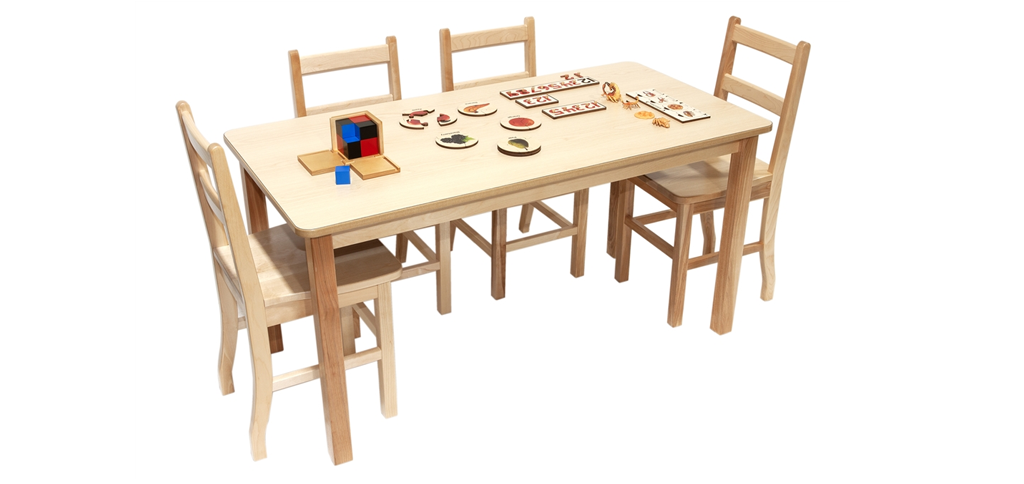
Storage Solutions for Creative Tools
Every art corner should have organized storage to help preschoolers manage supplies independently. The right daycare furniture makes this not only possible but efficient.
- Open cubbies and shelves: Allow children to see and choose materials, supporting autonomy and decision-making.
- Rolling carts: Ideal for mobile art stations; they can be moved to group areas or cleaned up quickly after activities.
- Clear bins with labels: This will help children learn where materials belong. Use pictures for non-readers and word labels for early literacy exposure.
With these solutions in place, art activities for preschoolers become more about creativity and less about chaos. Children also take greater ownership over their work when retrieving and returning materials independently.
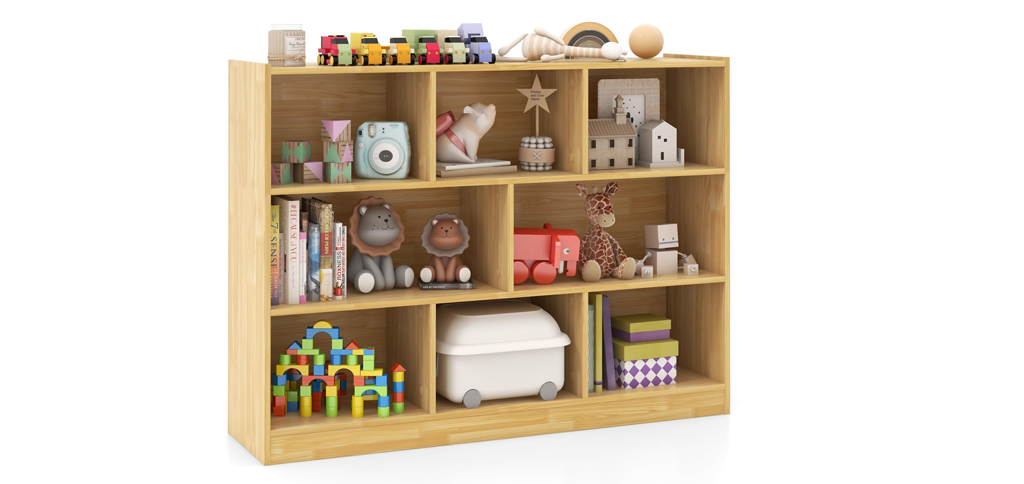
Display and Drying Space Matters
Artwork deserves to be celebrated—and preserved safely. Proper drying and display areas are essential in your art corner layout.
- Drying racks: Multi-tier drying racks prevent smudging and allow multiple paintings or collages to dry at once, which is especially important in classrooms with back-to-back activities.
- Wall display boards or gallery strips: These give children pride in their creations and encourage discussions about art among peers and educators.
- Clipboards or easel walls: These allow children to work vertically, strengthening their shoulder and core muscles, which is important for their pre-writing skills.
The right furniture in these areas helps reinforce the value of every child’s creative expression and makes art a visible, celebrated part of the daycare space.
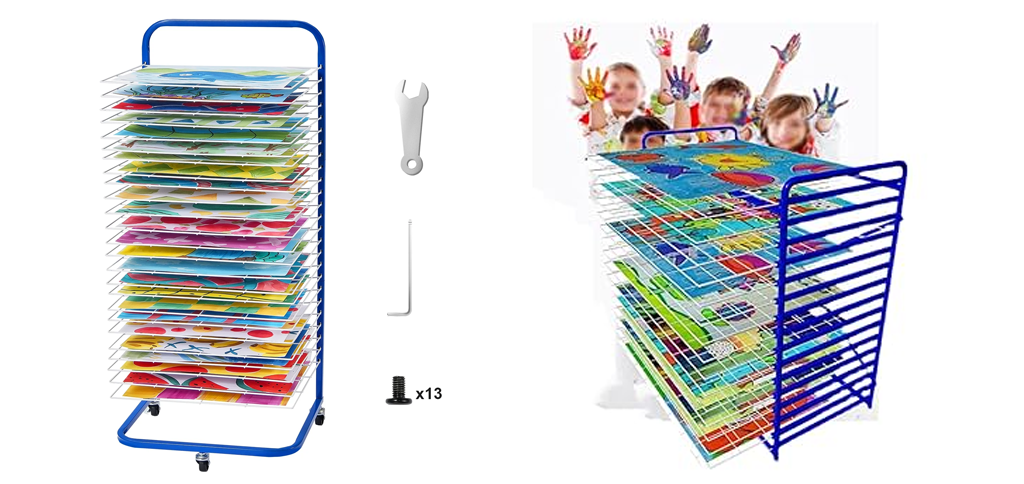
Creating a Safe and Flexible Layout
Designing a preschool art area isn’t only about materials—it’s also about how children move and interact within the space. Use daycare furniture to guide the flow:
- Defined zones: Low bookshelves or partition panels can subtly separate the art area from block play or reading nooks, keeping focus and reducing mess spread.
- Soft corners and rounded edges: Minimize risk in busy rooms. Choose daycare furniture with child-safe edges and stable construction.
- Multi-use surfaces: Some art tables can double as sensory stations or be flipped for dry-erase use. Flexibility is key in small spaces.
A well-designed art corner encourages choice, limits overwhelm, and supports the developmental benefits of art activities for preschoolers, such as fine motor growth, emotional expression, and creative problem-solving.
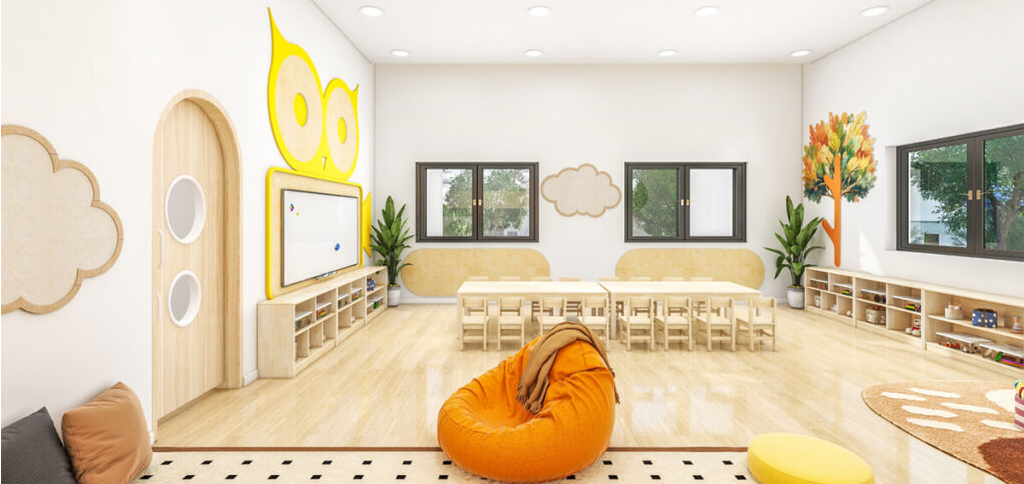
What to Watch Out for When Doing Art Activities for Preschoolers?
Art activities for preschoolers are naturally joyful, creative, and developmental—but they also require planning, structure, and safety awareness. While the freedom of artistic expression is crucial in early childhood, we, as educators, caregivers, and program directors, must ensure that these creative moments are also safe, age-appropriate, and supportive of learning goals.
There’s much more to preschool art than simply putting out paint and paper. The materials you choose, how you set up the environment, and how you guide the process all impact how meaningful and safe the experience will be.
Avoiding Unsafe Materials
Not all art supplies are created with young children in mind. Preschoolers are naturally curious and often explore materials with their hands—and sometimes their mouths. That’s why it’s important to use only non-toxic, washable, and age-appropriate art supplies. Check for certifications like ASTM D-4236 or EN71, which indicate child-safe materials. Avoid small parts that could pose choking hazards, especially in projects that use beads, buttons, or loose craft pieces.
In addition, be cautious with scissors, glue guns, or sharp objects. Use blunt-tip, child-safe scissors and always supervise closely when any cutting is involved.
Watch for Sensory Overload
While many art activities for preschoolers are designed to be sensory-rich, it’s possible to overwhelm a child with too many materials or textures at once. Some children may be sensitive to strong smells, sticky textures, or bright lighting. For sensory-sensitive people, simplify the activity by reducing the number of materials or offering alternatives like dry tools (crayons instead of finger paint).
Smocks, individual workspaces, and gentle music can also help create a calm, focused art environment that supports participation without stress.
Setting Clear Expectations and Clean-Up Routines
Art can be messy, and preschoolers thrive on routine. Before beginning an activity, clearly explain how materials should be used, how to ask for help, and how clean-up will work. Involving the children in setup and clean-up builds responsibility and teaches respect for shared materials and space.
Use labeled bins, color-coded tools, and visual instructions to help children follow along. A predictable structure reduces chaos and helps children focus more on the creative part of the experience.
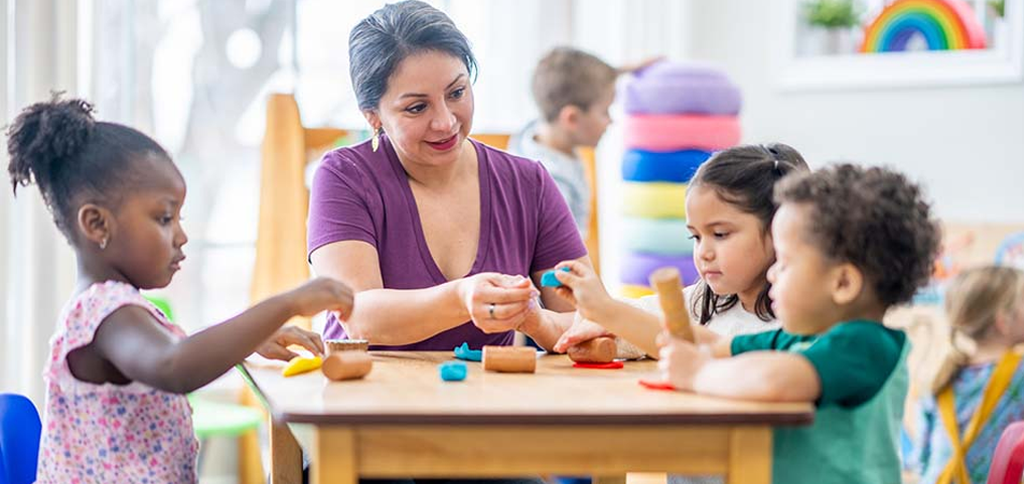
คำถามที่พบบ่อย
1. What type of daycare furniture is best for preschool art activities?
The best daycare furniture for art activities for preschoolers is child-sized, durable, and easy to clean. Tables should match preschoolers’ height for ergonomic comfort and stability. Look for rounded edges, non-toxic materials, and surfaces that resist staining from paint, glue, and markers. Matching chairs should be stackable or lightweight for easy rearrangement, allowing flexibility for both group and individual art projects.
2. How can I organize an art corner in a small daycare space?
Even in compact classrooms, a functional art corner is possible with clever use of daycare furniture. Use mobile storage carts, vertical shelving, and corner tables to maximize space. Choose clear bins with labels for easy material access and quick clean-up. Multi-use tables that double as sensory stations or dry-erase boards also help conserve space while still supporting a range of art activities for preschoolers.
3. Why is furniture design important in preschool art areas?
Furniture design directly impacts how children interact with their environment. For art activities for preschoolers, appropriate design fosters independence, improves posture during fine motor tasks, and reduces distractions. For example, low open shelves let children self-select materials, while defined zones help separate messy activities from quiet areas. Ergonomic chairs and stable tables reduce fatigue and allow longer focus during creative work.
4. How do I choose safe materials for preschool art projects?
Always prioritize safety when selecting materials for art activities for preschoolers. Choose only non-toxic, washable paints, glues, and markers with child-safety certifications like ASTM D-4236. Avoid small items that could be choking hazards for younger children. Also, use child-safe scissors and soft-edged tools, and supervise all cutting or glue-gun activities. Safety-conscious furniture—such as rounded corners and stable construction—further enhances the safe use of materials.
5. What should I include in an art station for preschoolers?
A well-equipped preschool art station should include child-sized tables and chairs, organized open storage for supplies, and accessible tools like scissors, glue, crayons, and paper. Complementary daycare furniture, such as mobile carts, drying racks, and easels, makes the space more versatile. Incorporating theme-based bins (e.g., “collage supplies,” “painting tools”) helps keep art activities for preschoolers engaging and developmentally appropriate.
6. How often should preschoolers participate in art activities?
Preschoolers should engage in art activities daily, even if only for 20 to 30 minutes. Consistent exposure to creative tasks helps reinforce motor development, imagination, and early academic concepts like color recognition and spatial awareness. Whether it’s painting, drawing, or crafting, making art a part of the daily routine supports emotional regulation and provides a healthy outlet for self-expression. Regular creative time also builds focus, independence, and a lifelong appreciation for visual exploration.
บทสรุป
Art is more than just play—it’s a vital part of early childhood development. From building fine motor skills and encouraging creativity to supporting emotional growth and collaborative learning, art activities for preschoolers lay the foundation for lifelong learning. Whether you’re organizing a structured classroom, creating an inspiring art corner, or choosing the right materials and methods, every detail matters. By combining thoughtful planning, safe practices, and age-appropriate tools, we can create meaningful art experiences that not only engage but truly empower young learners.






